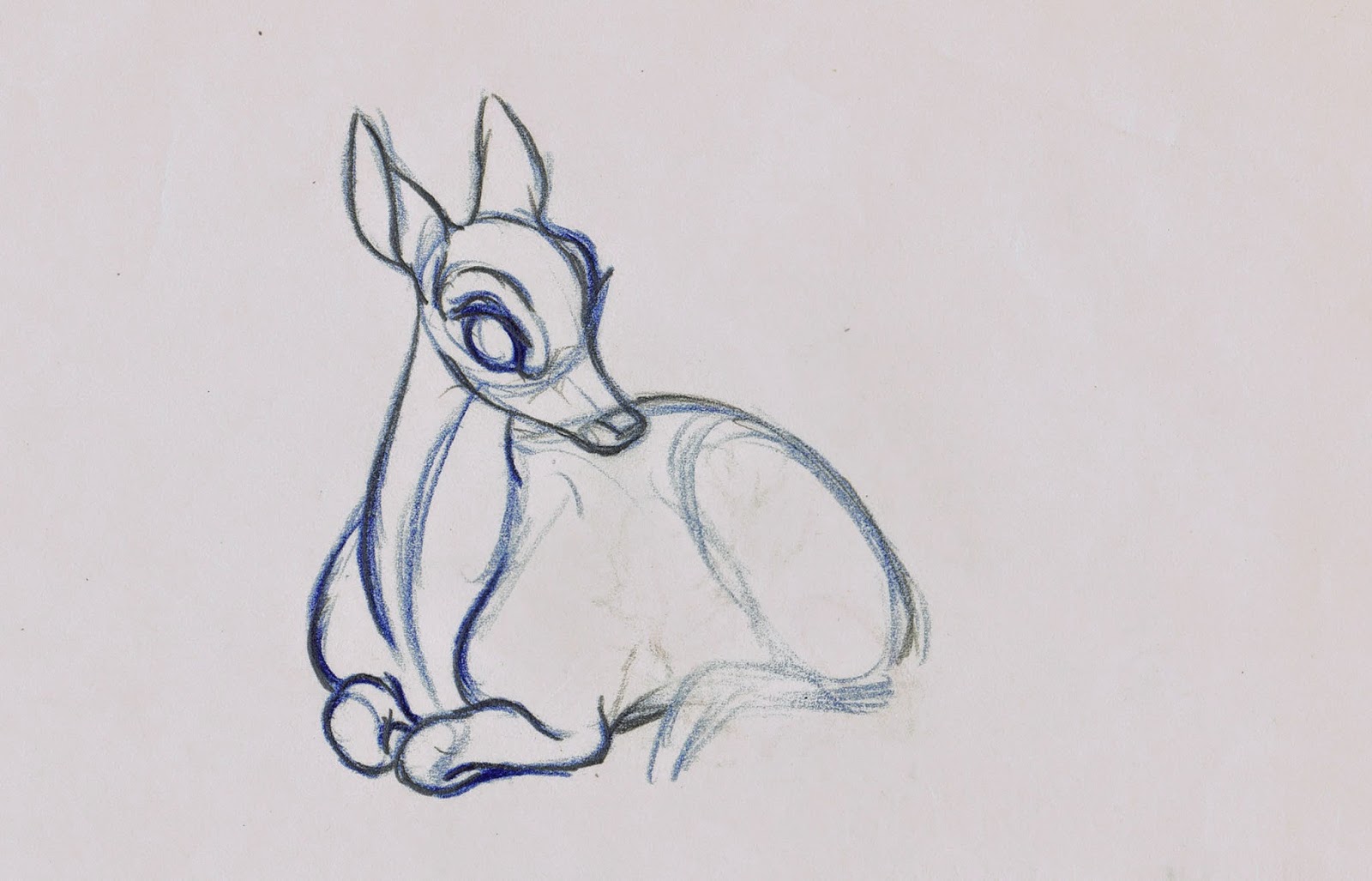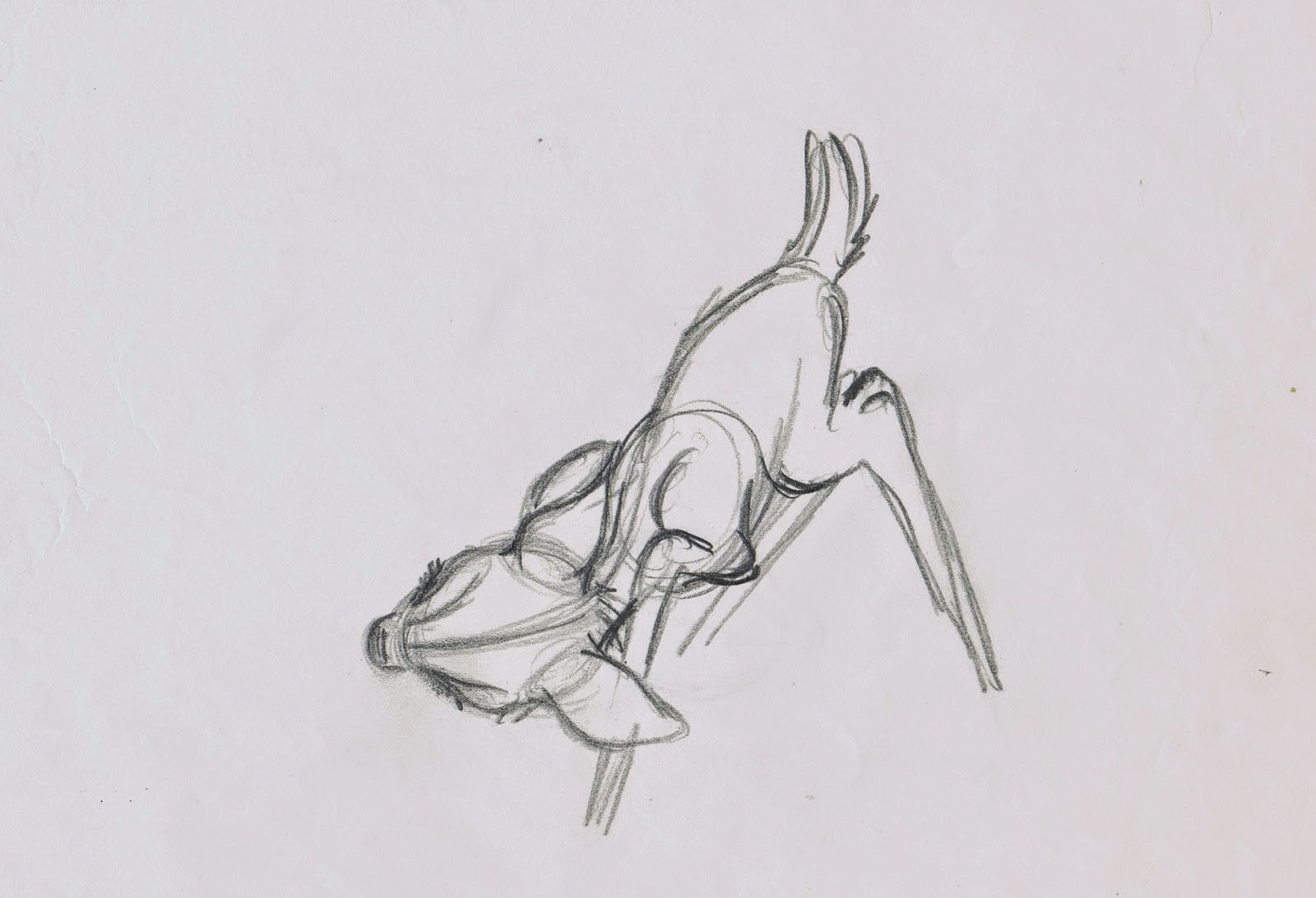Milt Kahl and some of his colleagues had a way of drawing and animating characters that seem to inhabit real space. Individual parts of the body connect organically, and there is a flow from one form into another. A full understanding of the character’s anatomy as well as perspective is the key to achieving this type of dimensionality.
Rough drawings, like the one above, often indicate how the animator solved drawing problems. They also show where time was spent and effort put into carving out correct, believable and interesting poses. In this sketch Milt was concerned with Bambi’s head in a down position, and how it connects to the body. Fascinating brain work.
Lady’s head is a pretty complex arrangement of basic and very subtle volumes. Her eyebrows sit on dimensional and flexible muscle parts, and her eyelids and lashes overlap the eyeballs. Every line is put down to give a three dimensional appearance.
This 3/4 back view could look awkward or boring, but by figuring out the correct angle with all its subtleties it comes off as a beautiful drawing.
Volumes in motion. What great rhythm from one form into another.
A potentially complicated pose reads very easily instead. The arrangement of Bambi’s mother’s front legs could present an elaborate anatomical study, but Milt found the simplest solution to make it look natural and elegant.
This doodle sheet shows great understanding of deer like, balanced poses.
It looks like Bambi just caught his balance in this awkward, but beautifully designed figure.
You can almost see the wobbly steps that would have preceded this pose.
Any twist in the overall body or head turn is helped by the indication of the center line, from tail to nose.
After animating in this rounded, sculpted style for a couple of decades, Milt and several others in the animation staff were ready for a change. Films like Sleeping Beauty and 101 Dalmatians had the animators focus on line and shape to achieve a much more graphic representation of their characters.












Awesome post
ReplyDeleteI am at CSSSA now which ils the calarts summer program
Did you ever come as a guest. It would be so cool
Yes, I used to come up regularly, but it's been a while.
ReplyDeleteMan, I wish I could achieve this level of looseness in my drawings. Milt's drawings are incredible examples for the idea of less is more. He uses the simplest lines to convey the most information. Like the poof below Lady's collar seems like just a scribble, yet it conveys so much about that part of her design. I am insanely jealous of Milt's skill, but I am also inspired to immediately get back to practicing.
ReplyDeleteGreat Post Andreas...as always!!! I sent my Email to you, is jrcdesenho@yahoo.com.br !!! Thank you!!!
ReplyDeleteHey Andreas, I'm a writer for Disney.com and would love to speak to you about an interview and to collect some of your thoughts, as a Disney animation expert, about the early animated films of Disney. If this would be of interest to you, please contact me at alexei.bochenek@disney.com.
ReplyDeleteThanks! Best, Alexei
Hi Andreas, keep these info sheets going and you'll be the author of "Drawn to Life 3!" In honor of Walt Stanchfield of course... I love those books.
ReplyDeleteThose books are pure genius! Pretty heavy stuff though, all those lectures on the left and right brain hemispheres :D Andreas' blog really is like an online artbook and one of the finest things the internet has to offer :)
DeleteBeautiful stuff. Thanks for these fantastic posts. It's amazing that these guys were still pretty young when they were doing Bambi, which is in my opinion the peak of the medium so far. It's so complex but elegant!
ReplyDeleteSo beautiful animation drawings. I always found Bambi's mother drawing to be the best part of the movie before she dies. She was so beautiful when we get to see the forest prince after birth. I've always wondered Andreas did you ever meet Mary Blair when you were working with the nine old men?
ReplyDeleteBeautifully sculpted indeed. I always come away from each post smiling and feeling inspired.
ReplyDeleteAndreas, I know Milt was used to do wire sculptures but I was wondering if he had any background in classic sculpture.
ReplyDeleteOnly what he got out of art books. I remember seeing Milt's name on many book cards from the studio's library. He checked out books on Picasso, children's books illustrated by the Provensens and other art history books.
Delete